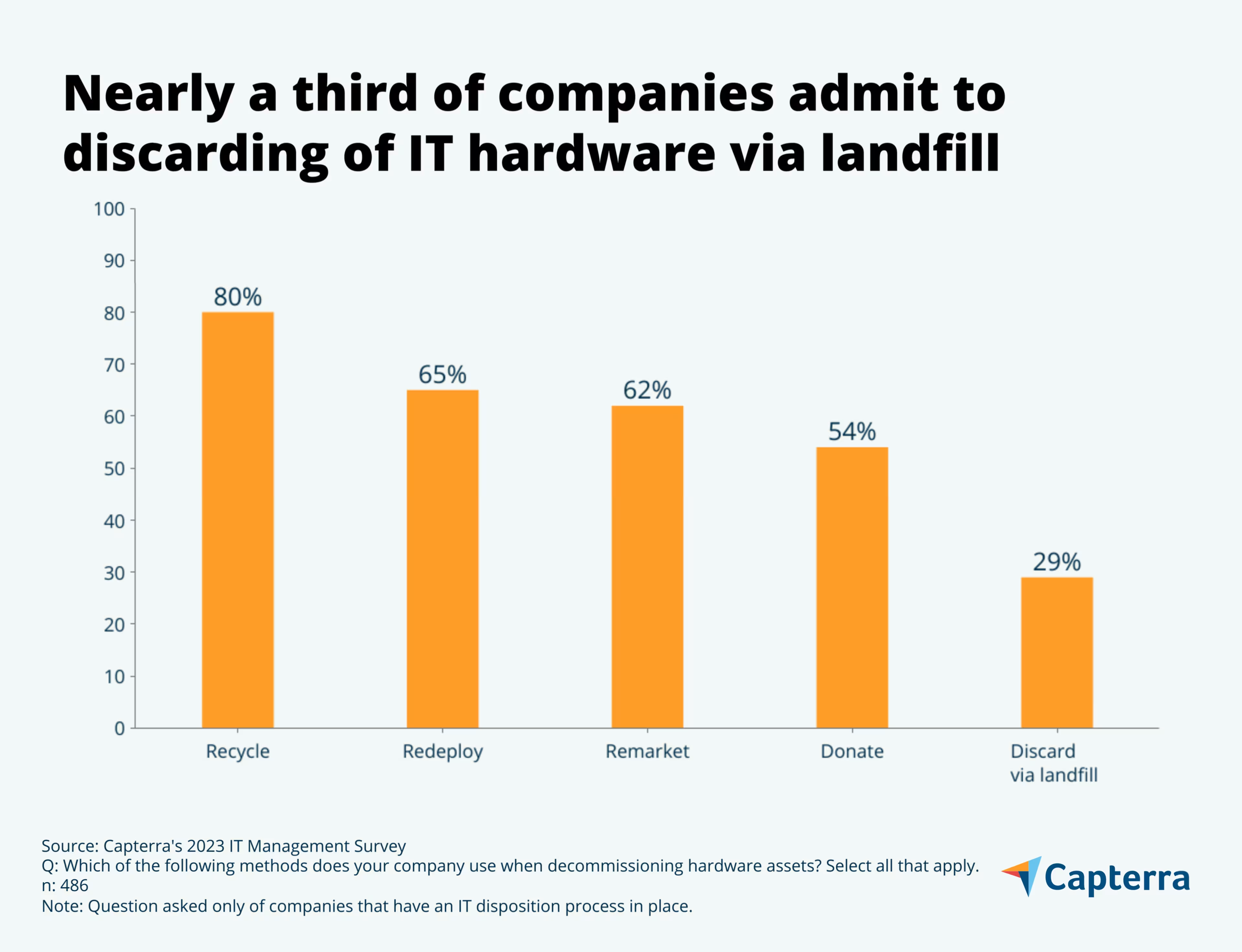Most companies dispose of IT assets properly—let's make sure yours is one of them.
Your business probably has a room somewhere full of old computers, routers, and other assorted IT hardware that's been sitting around for who knows how long (our research says 2.7 years on average). When the time comes, what should be done with all of your aging technology?
Most IT leaders dispose of assets responsibly. But our 2023 IT Management Survey* finds that a distressing number of companies choose to simply throw their old hardware in the garbage where it will end up in a landfill, polluting the environment with toxic chemicals. So, how can you keep your business from being one of them?
/ Key findings
Most companies recycle (80%), redeploy (65%), remarket (62%), or donate (54%) at least some of their IT hardware assets.
Nearly a third of companies (29%) use improper IT hardware disposal practices (i.e., discard via landfill).
The ability to organize and stage IT assets for disposal is a key factor in whether companies use proper or improper disposal practices—cost is not.
The vast majority of companies recycle IT hardware—but far too many simply throw it away
When it comes time to decommission IT assets, you have several good options including redeployment, remarketing, donation, or recycling—and one bad option, which is to simply toss your hardware in a dumpster.
Our results show that most companies use a combination of methods. By far, the most common approach used to dispose of used IT assets is recycling, practiced by 80% of the companies in our survey. About two in three companies (65%) redeploy IT hardware that is still in usable condition. Nearly as many (62%) remarket their assets (i.e., sell them on the secondary market), and a bit more than half (54%) donate IT assets to charitable organizations.
Unfortunately, nearly a third of companies (29%) admit to discarding IT hardware via landfill. This is a problem for several reasons, which we'll address later on.

Improper IT hardware disposal associated with younger companies
We pulled our data apart to compare companies that admit to disposing of IT hardware into landfills against those that say they dispose of IT hardware responsibly.
Compared to companies that dispose of hardware responsibly, our data show that companies engaging in irresponsible disposition practices are more likely to upgrade or replace hardware to scale their workforce, avoid obsolescence, and keep up with the competition. Along those same lines, irresponsible disposers are significantly less likely to reuse older devices (54%) than responsible disposers (69%).
Curiously, irresponsible disposers tend to have fewer total hardware assets, yet are more likely to lose track of them. These companies also tend to have fewer years in business, compared to companies that dispose of their older hardware more responsibly.
Disorder—not cost—drives irresponsible disposition practices
When asked about the struggles they face during the IT asset disposition process, several clear differences appear between companies with responsible and irresponsible disposition practices, along with some telling similarities.
Companies that throw away IT hardware report much more difficulty in organizing and staging their assets for disposal. Remarkably, they also voice significantly higher concerns about environmental impacts—perhaps stemming more from guilt than altruism. Maintaining a chain of custody, often required by industry regulations, is also more challenging for these companies which aligns with their aforementioned difficulties with organizing and staging assets.
What both groups have in common are similar struggles with both the cost of responsible disposal and identifying reputable e-waste vendors. This means that irresponsible disposal practices can't be blamed on either issue since both groups face them equally.

Instead of cost or the ability to find e-waste vendor help, the differentiating factors seem to revolve around organization, or a lack thereof.
Taking all of these factors into account, a picture emerges of a young business in a growth phase experiencing difficulties with IT asset management. It's not difficult to imagine a scenario where, after a few years in business, a pile of used IT assets begins to build up in a storage room and, amid competing priorities, a decision is made to take the easy way out. As the business matures, chaos gives way to order, processes are developed, and the company moves toward proper IT asset disposition processes.
Three reasons why you shouldn't throw away IT hardware
IT assets should only be disposed of through legitimate means because:
It might be illegal.
In some states, such as California, it's illegal to throw away some types of electronics, such as computers, servers, and other IT equipment. In fact, 25 states have now passed e-waste laws. [1] Additionally, privacy laws such as GDPR and several U.S. state laws require specific handling of consumer data when decommissioning IT hardware.
It might be regulated by your industry.
Companies that must maintain compliance with regulations such as HIPAA, GLBA, and PCI-DSS are required to use specific processes when disposing of IT assets that hold sensitive data.
It's definitely harmful to the environment.
IT hardware devices are often loaded with toxic chemicals that make them unsuitable for landfills or incinerators, and potentially devastating to the environment, not to mention people.
But deciding to recycle your IT assets is only the first step—you still have work to do to make sure it’s done correctly.
How can I dispose of IT assets responsibly?
If you need help ridding your business of IT assets, the best option might be to hire an IT asset disposition vendor (ITAD) or look to a reputable e-waste vendor. These organizations can help with secure data destruction and ensure that equipment is disposed of properly with minimal impact to the environment.
But it would be easy to take your money, assure you that your hardware will be disposed of properly, and then simply dump it in a landfill or maybe even ship it off to another country—scams that are more common than you might think. Take an infamous example from Seattle where an e-waste recycling company engaged in widespread fraud leading to jail sentences for its executives.[2]
The investigation was instigated by the Basel Action Network, a charitable foundation that uses trackers to document where purportedly recycled IT hardware ultimately, and often illegally, ends up, which all too often is in developing countries.[3] Numerous studies have documented the hazardous impacts of e-waste on developing nations such as Bangladesh where workers in e-waste facilities face exposure to heavy metals and dangerous chemicals.[4]
Clearly, it is important to take your time to identify reputable vendors before handing off your IT assets. Look for established companies with many years in service and check for compliance with one (or ideally more) of the following standards:
National Association for Information Destruction (NAID)
e-Stewards
ISO 14001 / ISO 18001 / ISO 9001
Responsible recycling (R2) standard
Also consider contacting the manufacturer or retailer from which you purchased your equipment. Many of these companies offer recycling programs for customers.
As mentioned earlier in our report, there are numerous organizations that are happy to take your gently used IT assets as donations. Here are a few of them:
If yours is a young and quickly growing company, make sure to prioritize IT asset management before IT asset disposition becomes overwhelming. Take a look at our IT asset management software shortlist to review tools and find a solution that fits your business.
